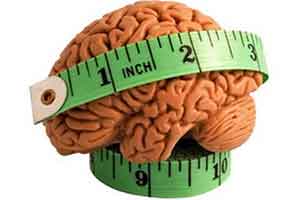Brain volume changes after CBT
 After just nine weeks of internet-delivered cognitive behavioural therapy, the brain of patients suffering from social anxiety disorder changes in volume. Anxiety is reduced, and parts of the patients’ brains decrease in both volume and activity. This study could help us develop more effective therapies for one of the most common problems in mental health.
After just nine weeks of internet-delivered cognitive behavioural therapy, the brain of patients suffering from social anxiety disorder changes in volume. Anxiety is reduced, and parts of the patients’ brains decrease in both volume and activity. This study could help us develop more effective therapies for one of the most common problems in mental health.
We have known for many years that the brain is remarkably adaptable. For instance, previous studies have shown that juggling and video games affect brain volume. However many questions about how the brain adapts remain unanswered.
A group of researchers from Linköping University and other Swedish universities has studied how internet-delivered cognitive behavioural therapy (ICBT) affects brain volume and activity. The researchers focussed on patients with social anxiety disorder (SAD), one of the most common mental health problems. Before and after treatment the brains of patients were examined with magnetic resonance imaging (MRI).
The researchers found that in patients with SAD, brain volume and activity in the amygdala decrease as a result of ICBT. The results are presented in Translational Psychiatry, a Nature publication.
“The greater the improvement we saw in the patients, the smaller the size of their amygdalae. The study also suggests that the reduction in volume drives the reduction in brain activity”, says doctoral student Kristoffer NT Månsson, who led the study together with Linköping colleague Gerhard Andersson and researchers from the Karolinska Institutet, Uppsala University, Umeå University and Stockholm University.
The study comprised 26 individuals treated over the internet for nine weeks, making it a relatively small study. However, it is unique in that it investigates multiple factors at the same time: post-treatment changes in both brain volume and brain activity.
“Although we didn’t look at that many patients, this work provides some important knowledge – especially for all the sufferers. Several studies have reported that certain areas of the brain differ between patients with and without anxiety disorders. We’ve shown that the patients can improve in nine weeks – and that this leads to structural differences in their brains”, says Kristoffer NT Månsson.
Kristoffer NT Månsson sees the study as a first step in a larger project. Ultimately the aim is to better understand the psychological and biological effects of treatment – in order to develop more effective therapies. The research team is now moving forward with studies on more patients. One study aims to identify the point during the treatment where the change in the brain occurs.
Source: Linköping Universitet
http://www.nature.com/tp/journal/v6/n2/full/tp2015218a.html

